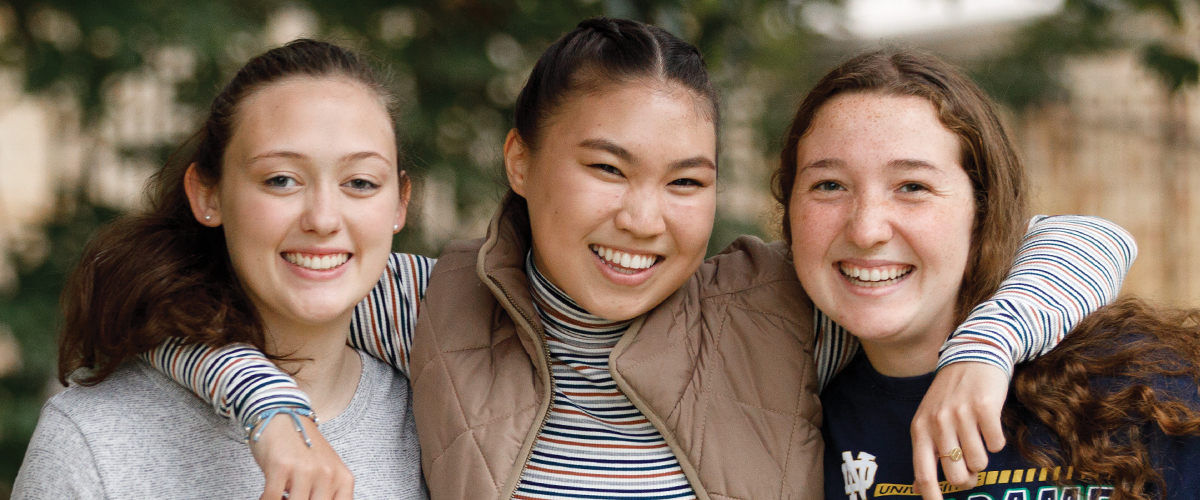Revere and Revise: Saint Mary's College 2030
The last full strategic plan for Saint Mary’s College, Boldly Forward, set the College on a course from 2012 to 2017. In the early weeks of my presidency, I discovered additional recent work the community had put into imagining its future. Recognizing the need to move quickly in the current environment—with a decline in the college-going population, rising costs to educate students, general economic strain, and a global pandemic—I capitalized on this work, dedicating significant effort to refreshing the community’s input and quickly completing a new plan.
To that end, over a four-month period, I hosted over 40 meetings, engaging every campus constituency, as well as the Sisters of the Holy Cross and external stakeholders such as employers and community partners. I also created two rounds of surveys and reviewed 1,032 responses from trustees, faculty, staff, students, parents, and alumnae. This feedback was generous; it shaped and reshaped the final plan.
I am thrilled and humbled by the creativity and the responsiveness of the Saint Mary’s College community—and confident that there is a great deal of support for the commitments and the recommendations outlined below. Saint Mary’s will be an even more robust institution if we can implement both the short-term and the long-term goals of this plan. While the ten-year horizon is ambitious, we will incorporate periodic reviews to ascertain the need for directional changes or new tactics.
A Strategic Planning Implementation Committee will provide oversight, implementation, and regular review of this plan—and will also monitor our progress and create a dashboard for both internal use and reporting to the Board of Trustees.

Katie Conboy, Ph.D.
President
January 2021
Note: The Strategic Plan is divided into the following five sections.
SECTION I
The Saint Mary's College Mission
SECTION II
Fundamental Principles and a New Strategy
SECTION III
The Vision for 2030
SECTION IV
The Plan: Commitments and Recommendations
SECTION V
Conclusion and Implementation Timeline
SECTION I:
THE SAINT MARY’S COLLEGE MISSION
This strategic planning process did not revisit the Saint Mary’s Mission Statement or the Statement of Philosophy and Purpose. These critical documents continue to animate our work on campus and remain deeply relevant to our future. Thus, they appear here in their current form.
Mission Statement
Founded by the Sisters of the Holy Cross in 1844, Saint Mary’s College promotes a life of intellectual vigor, aesthetic appreciation, religious sensibility, and social responsibility. Saint Mary’s is a Catholic, residential, women’s, liberal arts college offering undergraduate degrees and co-educational graduate programs. A pioneer in the education of women, the College fosters an inclusive, academic community where students discover and develop their talents as they prepare to make a difference in the world. All members of the College contribute to this mission in their response to the complex needs and challenges of contemporary life.
Statement of Philosophy and Purpose
As a center of higher education, Saint Mary’s fosters an academic climate of scholarship and learning for faculty and students alike. Through excellence in teaching and the example of its own active scholarship, the faculty challenges students to expand their horizons and supports them in their intellectual pursuits. A broad-based course of study invites students to think critically and creatively about the natural world and human culture. Acknowledging the need to prepare women for an array of careers, the College insists on a liberal arts foundation for all its students. Through their years at Saint Mary’s, students acquire depth and breadth of knowledge, competence in quantitative skills and modern languages, the ability to think clearly about complex problems, and the capacity to communicate with precision and style.
As a Catholic college, Saint Mary’s cultivates a community of intellectual inquiry, liturgical prayer, and social action. The College creates an open forum in which students freely and critically study the rich heritage of the Catholic tradition, raising the questions necessary to develop a mature religious life. The celebration of liturgy encourages students to explore the fullness of life and its mysteries. The College nurtures awareness and compassion for a troubled world and challenges students to promote human dignity throughout their lives. In preparing women for roles of leadership and action, Saint Mary’s pays particular attention to the rights and responsibilities of women in the worlds of work, church, community, and family.
Dedicated to the personal and social growth of its students, Saint Mary’s cultivates a community of students, faculty, and staff, which responds to the needs of women. In order to offer the richest educational experience possible, the College strives to bring together women of different nations, cultures, and races. It provides a residential environment where women grow in their appreciation of the strengths and needs of others. Through a host of co-curricular programs on campus and in the local community, Saint Mary’s initiates students in the habits of civic responsibility. Engaging in all aspects of the college experience, students acquire the hallmarks of a liberally educated woman: keen self-knowledge, lively imagination, lifelong intellectual and cultural interests, and the ability to make socially responsible choices about the future.
SECTION II:
FUNDAMENTAL PRINCIPLES AND A NEW STRATEGY
With the last approved strategic plan (Boldly Forward), the College articulated a number of fundamental principles. These principles remain in place, with only a few additions and adaptations, noted in italics:
Fundamental Principles
- Saint Mary’s is committed to providing students with an excellent intellectual and academic experience.
- Saint Mary’s is unwavering in its commitment to being a Catholic and Holy Cross college.
- Saint Mary’s is committed to the education of undergraduate women and to graduate programs open to all.
- Saint Mary’s is committed to being a residential college at the undergraduate level.
- Saint Mary’s is committed to developing a serious graduate student culture, including opportunities for residential graduate student experience.
- Saint Mary’s is committed to accessibility for students who can attend Saint Mary’s only in an online format.
- Saint Mary’s is committed to campus sustainability.
While the original principles endure, the current environment requires a new strategy for Saint Mary’s to fulfill its mission.
The Strategy
The current environment demands that Saint Mary’s—an inclusive and transformative Catholic academic community—expand its audiences, understand their aspirations, and respond differently than peer institutions. It insists that we differentiate our approach and articulate our outcomes in ways these new audiences will find compelling. This differentiation must emerge from our core values—Learning, Community, Faith/Spirituality, and Justice—as well as from our historic identity as a primarily undergraduate, Catholic, women’s, liberal arts college that is guided by the enduring work of our founders and ongoing sponsors, the Sisters of the Holy Cross.
In this period of changing U.S. demographics and global connection, Saint Mary’s must renew its commitment to meeting the needs of the times—expanding the boundaries of who we are and imagining in fresh ways who we can be. By doing so, we will sustain and expand our mission, thus becoming more accessible, attractive, and hospitable to rapidly diversifying undergraduate and adult student populations.
SECTION III:
THE VISION FOR 2030
The mission and the purpose of Saint Mary’s remain unchanged, but the vision for how to advance the mission over the next ten years is innovative, adding a new dimension to future aspirations for Saint Mary’s College.
Vision Statement
By 2030, Saint Mary’s College will be acclaimed for a diverse student body educated to promote justice and human dignity in their communities and their careers and will be recognized for national leadership in empowering, enriching, and advancing women at all stages of life.
SECTION IV—THE PLAN:
COMMITMENTS AND RECOMMENDATIONS
Revere and Revise: Saint Mary’s College 2030 includes four complex commitments and 24 tactical recommendations that will bring those commitments to life. The commitments are followed by an implementation timeline that indicates the three phases of the plan. The second and third phases will continue to be somewhat flexible as we remain open to new ideas and acknowledge the need to build on the successes of each implementation period.
Commitment 1
Achieve a Culture of Human Dignity and Solidarity
Commitment 2
Establish Saint Mary’s as a Leader in the Social and Economic Empowerment of Women
Commitment 3
Elevate Our Research Focus
Commitment 4
Stabilize and Enhance Financial Performance
Commitment 1:
Achieve a Culture of Human Dignity and Solidarity
Saint Mary’s College will promote the Holy Cross emphasis on the whole person by creating a culture of belonging and mattering. We will be a community committed to human dignity, invigorated by difference, and prepared to build in all members the skills to infuse their lives and work with inclusive values.
Recommendation 1.A
Reduce economic and social barriers to success for our students.
- Create an Office for Student Equity to help under-resourced students access the full Saint Mary’s experience.
- Continue to diversify our campus community.
- Secure space to support LGBTQ+ students.
Recommendation 1.B
In keeping with our Catholic identity, foster wholeness and resilience through invitations to step out of isolation and into community.
- Revisit the “wholeness framework” to build campus-wide commitment and buy-in to wholeness as a signature component of the Saint Mary’s experience.
- Engage faculty and staff in a comprehensive effort to understand their experience of community; discern how the pandemic has changed our experience of connection and belonging.
- Develop a plan to build understanding of and respect for the full range of work that makes Saint Mary’s a model community.
- Ensure dignity of work through compensation at market rates.
Recommendation 1.C
Promote spiritual offerings from the world’s diverse faith traditions as part of our contribution to the renewal of Catholic life.
- Expand curricular and co-curricular opportunities for students to understand different faith traditions and to learn about their commonalities.
- Create a new sacred space on campus that is accessible and inviting for all students.
- Co-locate current offices to create a home for Campus Ministry that is central to campus life—in the student center.
Recommendation 1.D
Establish diversity, equity, inclusion, and justice education for all constituencies as an essential element of the Saint Mary’s culture.
- Implement appropriate and ongoing DEI education for all constituencies, beginning with the Board of Trustees.
- Educate students specifically on their responsibility to create a student culture of belonging, where people feel they matter to one another.
- Help students understand how they can carry what they have learned about inclusion and justice into their future communities and workplaces.
Recommendation 1.E
Ensure an inclusive curriculum and inclusive pedagogies.
- Establish a program review process that inquires into how the contributions of underrepresented groups are included in each discipline.
- Offer continuing workshops for faculty on inclusive classroom practices.
Recommendation 1.F
Embed conversations across differences into the core curriculum, addressing multicultural and global perspectives, grounded in Catholic social teachings.
- Scale up our current Dialogue and Civil Discourse program as part of the core curriculum and make it a hallmark of a Saint Mary’s education, building leaders equipped with the skills and confidence to have difficult conversations with people who disagree with them.
- Support the initial curricular focus with co-curricular programs designed to allow students to practice these skills.
Recommendation 1.G
Invest in faith, health, and wellness initiatives to teach and model work-life integration.
- Adopt specific practices that demonstrate our commitment to be a workplace that values and models balance and resiliency.
Recommendation 1.H
Define the College’s sustainability and environmental stewardship road map.
- Build on the excellent sustainability work already accomplished at the College by creating a ten-year plan for new sustainability initiatives.
- Incorporate the sustainable farm into the curriculum and the co-curriculum.
- Identify other areas of curricular growth that will encourage these values.
Commitment 2:
Establish Saint Mary’s as a Leader in the Social and Economic Empowerment of Women
As the only women’s college in the state of Indiana and one of only three dozen in the United States, Saint Mary’s College will empower its undergraduate students by connecting the liberal arts and professional life through robust curriculum-to-career preparation and accelerated pathways to graduate education. In addition, we will extend beyond our core enterprises of baccalaureate, masters, and doctoral programs and fulfill an obligation to serve girls and women at every point in the life cycle.
Recommendation 2.A
Infuse curriculum-to-career preparation that serves students in all disciplines, including opportunities to earn credentials for profession skill sets.
- Craft a curriculum-to-career model that provides opportunities for all Saint Mary’s students to earn professional credentials in addition to their liberal arts education.
- Develop job shadowing experiences for first-year and sophomore students. Expand and standardize internship/externship/co-op opportunities for juniors, seniors, and graduate students.
- Design a suite of credentials that develop specialized skills and include notation on student transcripts.
Recommendation 2.B
Diversify and expand curricular and experiential learning for students to discover their vocations.
- Incorporate into the academic experience new opportunities for design thinking, problem-based learning, leadership development, entrepreneurship, and global study/internships in the developing world.
Recommendation 2.C
Build expedited pathways to graduate programs, with special consideration for online graduate opportunities.
- Advance—in collaboration with the tri-campus community—a roadmap for graduate education that creates a Saint Mary’s “value proposition” for students to attain two degrees in five years or less.
- Add at least one graduate program each of the first three years of the plan, with a focus on enhancing the College’s existing strengths in graduate education, such as in the health sciences.
- Generate online opportunities to expand the reach of our graduate programs.
Recommendation 2.D
Maximize relationships with women- and girl-serving organizations throughout the region and the nation.
- Use alumnae networks and faculty, staff, and parent relationships to connect Saint Mary’s to additional partner organizations and to ascertain how we can enhance their programming and educational needs.
Recommendation 2.E
Grow a suite of pre-college leadership programs and college preparatory programs that maximize campus use.
- Introduce new leadership programs and college preparatory programs, especially in the summer months, that not only expand our reputation for leadership but also utilize the campus more fully for generating additional revenue.
Recommendation 2.F
Develop a full range of programming for adult women, both college-educated and not, to gain skills and academic credentials.
- Institute a model of “credit for prior experience” that is consistent with the educational values of Saint Mary’s.
- Offer a limited number of Saint Mary’s academic majors in an expedited format for adult women who may have no college education or some college credit but no degree.
- Formulate credentials for adult women returning to the workforce.
- Organize stackable credentials for adults who may want to achieve an undergraduate or graduate degree over time.
Recommendation 2.G
Contribute to the leadership of women in the Catholic Church, inspired by the Sisters of the Holy Cross as social justice leaders and leaders in the professions.
- Provide educational programs consistent with the commitments of the Sisters of the Holy Cross for lay and professed religious women interested in Church leadership or in serving church-affiliated entities in professional contexts (e.g., education, healthcare, social work, and immigration services).
Commitment 3:
Elevate Our Research Focus
Recognizing that teaching and research are related enterprises, Saint Mary’s College will infuse research and evidence-based practice into the curriculum, develop new mentored student research opportunities, expand applied and experiential opportunities, and highlight faculty and student-faculty research as signature elements of our educational focus.
Recommendation 3.A
Design a progressive and robust emphasis on student research that includes research in course work or conducted independently during the academic year--as well as a competitive summer research program open to students in all disciplines.
- Bolster support for information literacy in the curriculum.
- Ensure early introduction to research methodologies for students in all disciplines.
- Introduce a programmatic “umbrella” for mentored student research opportunities in the summer months, expanding these opportunities through a combination of fundraising and operational budget growth.
- Frame a systematic approach to credit-bearing independent research for students either preparing for summer research or extending a summer research experience.
- Seek ways to make research build on itself, including preparing students for research elsewhere—through competitive Research Experiences for Undergraduates (REUs), often associated with the National Science Foundation and other programs such as the Boren Critical Language Scholarships, or post-graduate fellowships and awards.
- Designate funding for graduate student research opportunities.
Recommendation 3.B
Revamp the Center for Academic Innovation (CFAI) to include a more comprehensive research focus beyond managing internal grants.
- Launch a program to introduce students to undergraduate and post-graduate fellowships and awards (e.g., Fulbright, Marshall, and Rhodes fellowships) and to assist them in applying.
- Provide dedicated support for faculty seeking grants, sponsored programs, and corporation or foundation support for research projects.
- Set up program support for managing the annual undergraduate research symposium and the summer research program.
- Create collaborative efforts among library, archives, IT, and faculty to promote digital humanities.
Recommendation 3.C
Promote faculty research contributions across all disciplines.
- Forge a definition of research that encompasses all Saint Mary’s academic programs, including the research of discovery, research related to policy and practice, community-based research, and research dedicated to creative pedagogies.
- Form a collaboration among library, archives, IT, and faculty to promote digital humanities.
- Make faculty research and student-faculty research collaborations visible as a signature value on the Saint Mary’s website, in the Courier, and throughout admissions materials.
Recommendation 3.D
Highlight and specifically support research on important markers of our identity.
- Discover new financial support for research in areas we define as of high reputational value to Saint Mary’s—such as research on women; on Catholic life, thought, and social teachings; on diversity, equity, and inclusion; on innovative pedagogies; and on the markers of a healthy campus culture.
Commitment 4:
Stabilize and Enhance Financial Performance
In order to evolve and expand, Saint Mary’s College must follow disciplined financial practices to solidify a secure foundation on which to innovate. Stable enrollment, strong retention, diversified revenues, and new operational efficiencies will enable the College to grow.
Recommendation 4.A
Increase and stabilize undergraduate enrollment.
- Move from a goal of 420 enrolled first-year students for 2021 to 450 enrolled first-year students by 2024.
- Fix a new target for expected undergraduate enrollment in 2030, with the goal of maximizing campus infrastructure and personnel, including residence halls, dining commons, full-time faculty, and staff.
- Reduce discount rate and increase net revenue per student—aiming for a total cost of attendance-to-revenue ratio of at least 50 percent—or $30K in 2020 USD.
- Grow revenues to achieve <60 percent of annual revenue spent on personnel by 2030.
Recommendation 4.B
Raise first-to-second year retention by two percentage points each year to reach a goal of at least 90%.
- Determine more precisely the reasons for attrition and map each reason to mitigation strategies.
- Begin with creative low- or no-cost measures to improve student success.
- Measure the retention effects of implementing Commitment #1 in this plan.
Recommendation 4.C
Cultivate graduate enrollment, adding at least one program each year for the first three years while expanding the reach of existing programs through online course delivery.
- Ascertain the highest potential graduate programs that advance areas of focus for Saint Mary’s.
- Introduce at least three new graduate programs (see Recommendation 2.C).
- Prioritize the addition of online programs.
- Realize >35% of revenue from sources other than undergraduate tuition, some part of which will be from graduate tuition.
Recommendation 4.D
Grow the endowment to $500 million by 2030, reducing the pressure on annual operating revenues and supporting key student needs.
- Move toward a budget in which endowment spending comprises >25% of operating revenues.
- Fund at least 50% of institutional tuition grant aid from the endowment.
- Attain an annual budgeted surplus of 5% within the operating budget (50% to be used for new initiatives and 50% for endowment growth, supporting intergenerational equity).
Recommendation 4.E
Improve the efficiency of core business functions, especially through improved technology—reducing manual effort, improving data-based decision-making, and elevating productivity across the entire campus.
- Replace the current telephonic service with new Voice-over-Internet-Protocol system (VoIP).
- Evaluate institutional business practices across all units.
- Implement a new Enterprise Resources Planning system (ERP).

SECTION V—CONCLUSION AND IMPLEMENTATION TIMELINE
Realizing the commitments and recommendations of this plan will position Saint Mary’s College for the future. The final commitment—stronger financial performance—is the key to advancing all other commitments. Saint Mary’s has always been the preeminent Catholic women’s college in the United States. Preparing now for a more diverse student body and a more diverse world, for career readiness, for a curated selection of graduate programs, for the needs of new audiences that will extend our educational focus, and for the importance of research and evidence-based practice in the world of work will strengthen our foundation for decades to come.
Implementation Timeline
Renewal and Revision: Now–2024
Activities
- Plan, prioritize, engage, and initiate
- Focus on the redirection and/or enhancement of existing programs and initiatives
- Identify and redirect non-strategic resource/expense allocation
- Community culture work
- Fundraising
Outcomes
- Stabilize revenues and reverse declines
- Initiate tuition revenue diversification
- Lay a foundation for growth
- Strengthen brand and reputation
Growth and Differentiation: 2024–2027
Activities
- Return to strategic plan to confirm ongoing direction
- Expand successful programs from “Renewal and Revision” years
- Launch new initiatives proposed in the plan
- Ongoing fundraising
Outcomes
- Grow and further diversify tuition revenue
- Diversify non-tuition revenue
- Establish core curricular impact
Mission Expansion: 2028–2030
Activities
- Launch final new initiatives
- Establish broad reputational recognition according to the goals of the strategic plan
- Set the course for the next ten years
Outcomes
- Achieve all metrics identified herein as markers of a sustainable institution
- Grow quality, reputation, and reach




